MARKETING
Diving for Pearls: A Guide to Long Tail Keywords – Next Level

Welcome to this refreshed installment of our educational Next Level series! Originally published in June 2016 this blog has been rewritten to include new tool screenshots and refreshed workflows. Together we’ll uncover keywords in the vastness of the long tail.
Looking for more Next Level posts? Previously we explored how to create relevant and engaging SEO reports.
One of the biggest obstacles to driving forward your business online is being able to rank well for keywords that people are searching for. Getting your lovely URLs to show up in those precious top positions — and gaining a good portion of the visitors behind the searches — can feel like an impossible dream. Particularly if you’re working on a newish site on a modest budget within a competitive niche.
Well, strap yourself in, because today we’re going to live that dream. I’ll take you through the bronze, silver, and gold levels of finding, assessing, and targeting long tail keywords so you can start getting visitors to your site that are primed and ready to convert.
Quick steps to building a long tail keyword list:
-
Draw from your industry and customer knowledge
-
Add suggestions from Google Autocomplete
-
Explore industry language on social media
-
Pull relevant suggestions from a keyword tool
-
Prioritize using popularity and difficulty metrics
-
Understand the competitive landscape to pinpoint opportunities
What are long tail keywords?
The “long tail of search” refers to the many weird and wonderful ways the diverse people of the world search for any given niche.
People (yes, people! Shiny, happy, everyday, run-of-the-mill, muesli-eating, credit-card-swiping people!) rarely stop searching broad and generic ‘head’ keywords, like “web design” or “camera” or “sailor moon.”
They clarify their search with emotional triggers, technical terms they’ve learned from reading forums, and compare features and prices before mustering up the courage to commit and convert on your site.
The long tail is packed with searches like “best web designer in Nottingham” or “mirrorless camera 4k video 2016” or “sailor moon cat costume.”
This adaptation of the Search Demand Curve chart visualizes the long tail of search by using the tried and tested “Internet loves cats + animated gifs are the coolest = SUCCESS” formula.
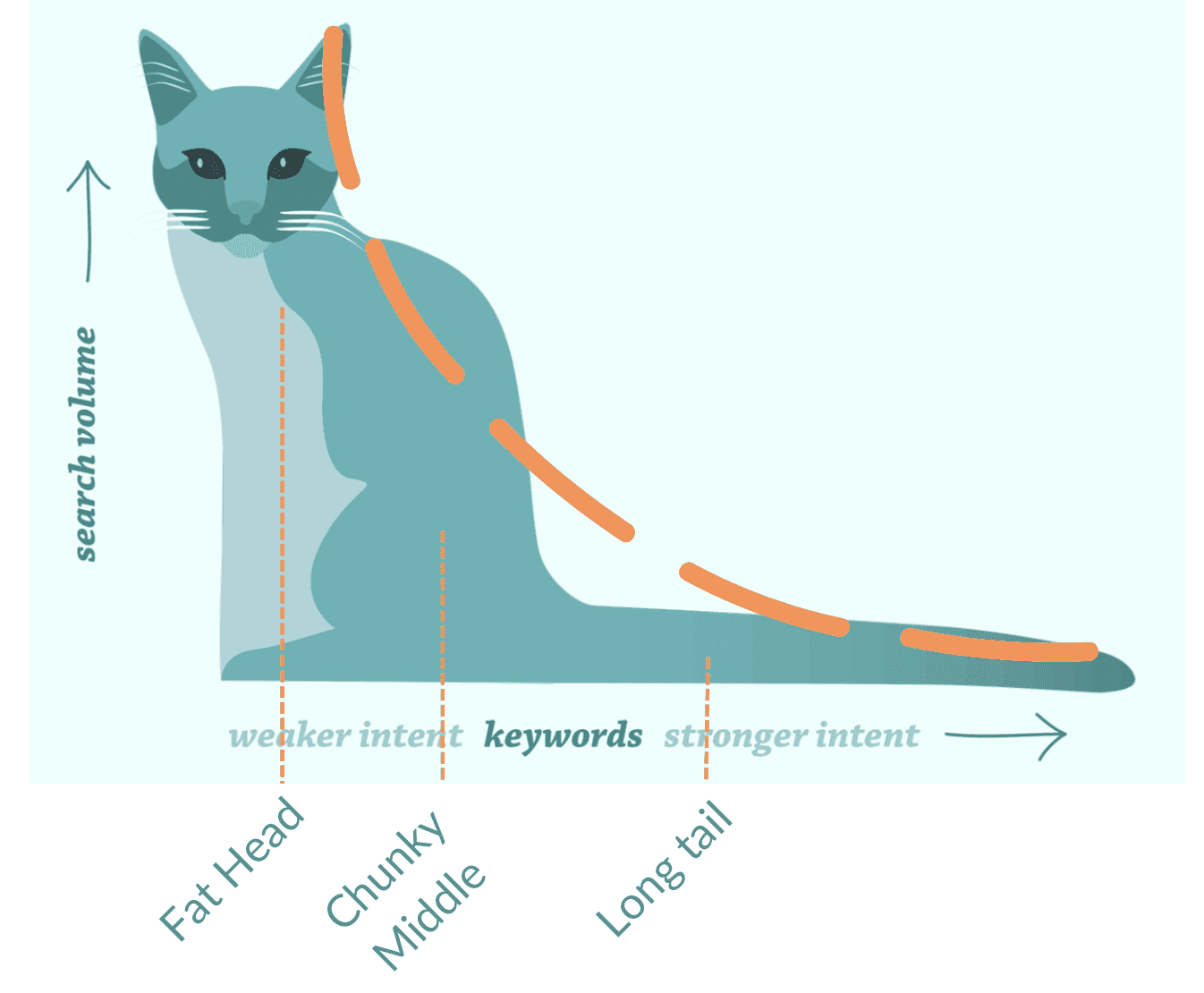
The Search Demand Curve illustrates that while “head” and “body” terms typically amass higher search volume, seeming appealing at first. The vastness of the “long tail” presents a more substantial opportunity and larger percentage of search traffic that shouldn’t be ignored. You can really see this illustrated when combined as a percentage of search traffic. While this graph contains no cats, it is still entirely illustrative. However the long tail of search isn’t slowing down anytime soon with voice search and AI integrations we can expect the vastness of the long tail to continue to grow.

While search volume for any individual long tail keyword is typically less, user intent is much more specific and viewed as a group targeting the long tail often enables you to target a larger more engaged audience. Also beautifully illustrated in Dr. Pete’s infamous chunky thorax post.
The long tail of search is being constantly generated by people seeking answers from the Internet hive mind. There’s no end to what you’ll find if you have a good old rummage about, including: Questions, styles, colors, brands, concerns, peeves, desires, hopes, dreams… and everything in between.
Fresh, new, outrageous, often bizarre keywords. If you’ve done any keyword research you’ll know what I mean by bizarre. Things a person wouldn’t admit to their best friend, therapist, or doctor they’ll happily pump into Google and hit search. In this post we’re going to go diving for pearls: keywords with searcher intent, high demand, low competition, and a spot on the SERPs just for you.
Bronze medal: Build your own long tail keyword
It’s really easy to come up with a long tail keyword. You can use your brain, gather some thoughts, take a stab in the dark, and throw a few keyword modifiers around your ‘head’ keyword.
Have you ever played that magnetic fridge poetry game? It’s a bit like that. You can play online if (like me) you have an aversion to physical things.

I’m no poet, but I think I deserve a medal for this attempt, and now I really want some “hot seasonal berry water.”
Magnetic poetry not doing it for you? Don’t worry — that’s only the beginning.
Use your industry knowledge
Time to draw on that valuable industry knowledge you’ve been storing up, jot down some ideas, and think about intent and common misconceptions. I’m going to use the example pearls or freshwater pearls in this post as the head term because that’s something I’m interested in.
Let’s go! Let’s say I run a jewelry business and I know that my customers regularly have questions, like:
How do I clean freshwater pearls
Using my knowledge I can rattle off and build a keyword list.
Search your keyword
Engage google suggested search tool to get some more ideas. Manually enter your keyword into Google and prompting it to populate popular suggestions, like I’ve done below:

Awesome, I’m adding Freshwater pearls price to my list.
Explore the language of social media
Get amongst the over-sharers and have a look at what people are chatting about on social media by searching your keyword in Twitter, tiktok, Instagram, and Youtube. These are topics in your niche that people are talking about right now.
YouTube is also pulling up some interesting ideas around my keyword. This is simultaneously helping me gather keyword ideas and giving me a good sense about what content is already out there. Don’t worry, we’ll touch on content later on in this post. 🙂

I’m adding understanding types of pearls and Difference between saltwater and freshwater pearls to my list.
Ask keyword questions…?
You’ll probably notice that I’ve added a question mark to a phrase that is not a question, just to mess with you all. Apologies for the confusing internal-reading-voice-upwards-inflection.
Questions are my favorite types of keywords. What!? You don’t have a fav keyword type? Well, you do now — trust me.
Answer the Public is packed with questions radiating out from your seed term
Pop freshwater pearls into the tool and grab some questions for our growing list.
To leave no rock unturned (or no mollusk unshucked), let’s pop over to Google Search Console to find keywords that are already sending you traffic (and discover any mismatches between your content and user intent.)
Pile these into a list, like I’ve done in this spreadsheet.
Now this is starting to look interesting: we’ve got some keyword modifiers, some clear buying signals, and a better idea of what people might be looking for around “freshwater pearls.”
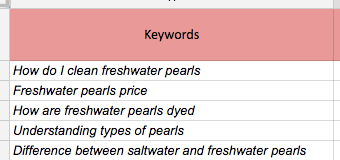
Should you stop there? I’m flabbergasted — how can you even suggest that?! This is only the beginning. 🙂
Silver medal: Assess demand and explore topics
So far, so rosy. But we’ve been focusing on finding keywords, picking them up, and stashing them in our collection like colored glass at the seaside.
To really dig into the endless tail of your niche, you’ll need a keyword tool like our very own Keyword Explorer. This is invaluable for finding topics within your niche that present a real opportunity for your site.
If you’re trying out Keyword Explorer for the first time, you’ll have 10 free searches/mo with a free Moz Community account and even more with a Moz Pro free trial or paid subscription.
Find search volume for your head keyword
To start, enter a broad industry keyword. In my case I’ll type in “pearls” into the Keyword Explorer search box. Now you can see Moz’s Monthly Volume displaying how often a term or phrase is searched for in Google:

Now try “freshwater pearls.” As expected, the search volume goes down, but we’re getting more specific.
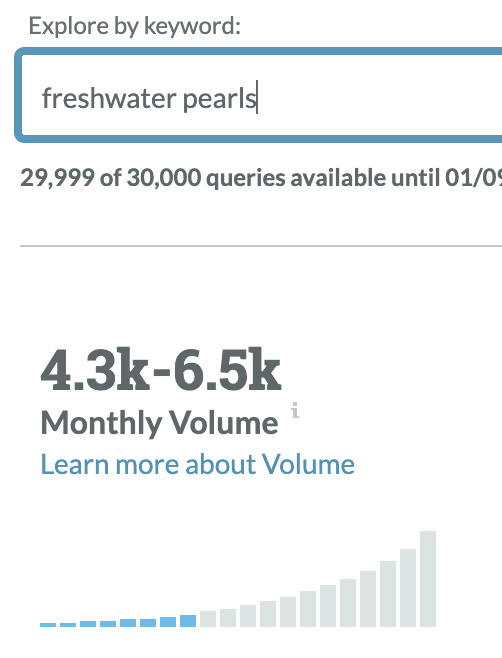
We could keep going like this, but we’re going to burn up all our free searches. Just take it as read that, as you get more specific and enter all the phrases we found earlier, the search volume will decrease even more. There may not be any data at all. That’s why you need to explore the searches around this main keyword.
Find even more long tail keywords
Below the search volume, click on “Keyword Suggestions.”

Well, hi there, ever-expanding long tail! We’ve gone from a handful of keywords pulled together manually from different sources to 1,000 suggestions right there on your screen. Positioned right next to that, search volume to give us an idea of demand.
The diversity of searches within your niche is just as important as that big number we saw at the beginning, because it shows you how much demand there is for this niche as a whole. We’re also learning more about searcher intent.
I’m scanning through those 1,000 suggestions and looking for other terms that pop up again and again. I’m also looking for signals and different ways the words are being used to pick out words to expand my list.
I like to toggle between sorting by Relevancy and search volume, and then scroll through all the results to cherry-pick those that catch my eye.
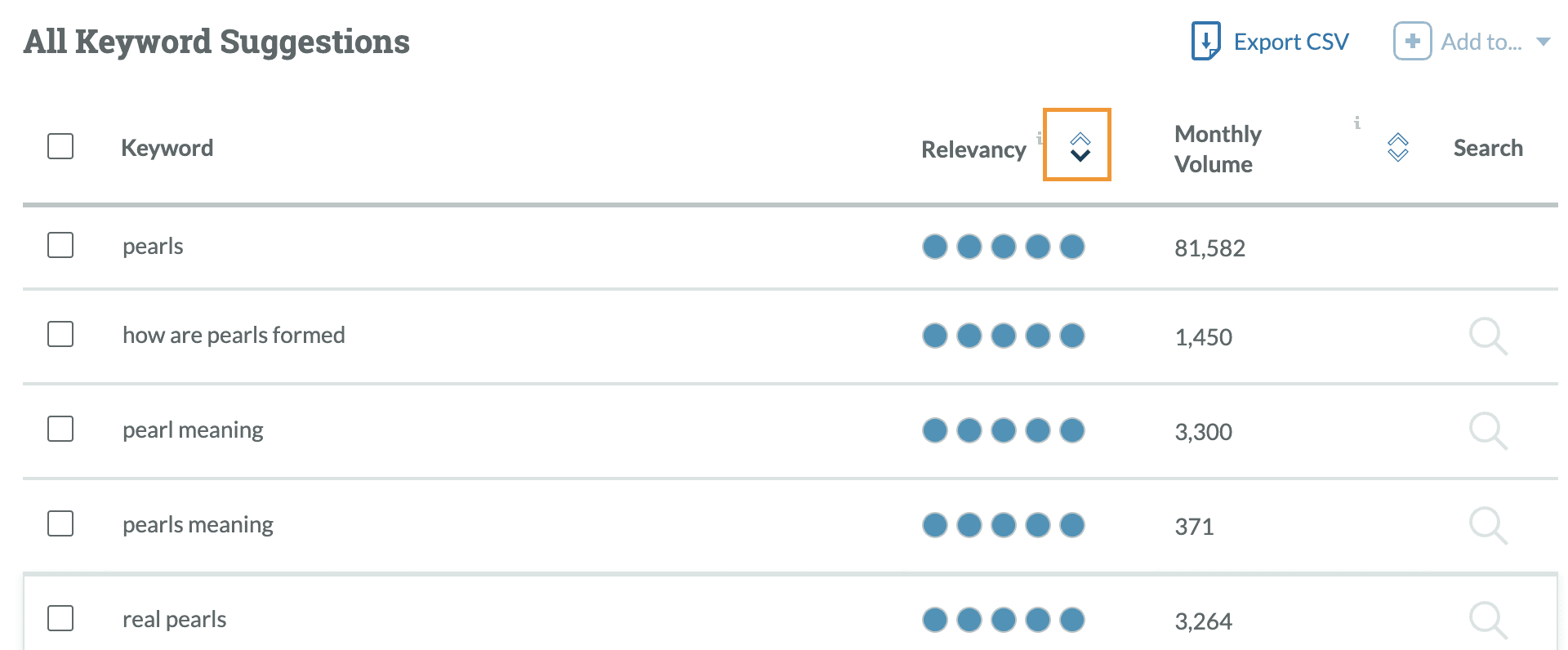
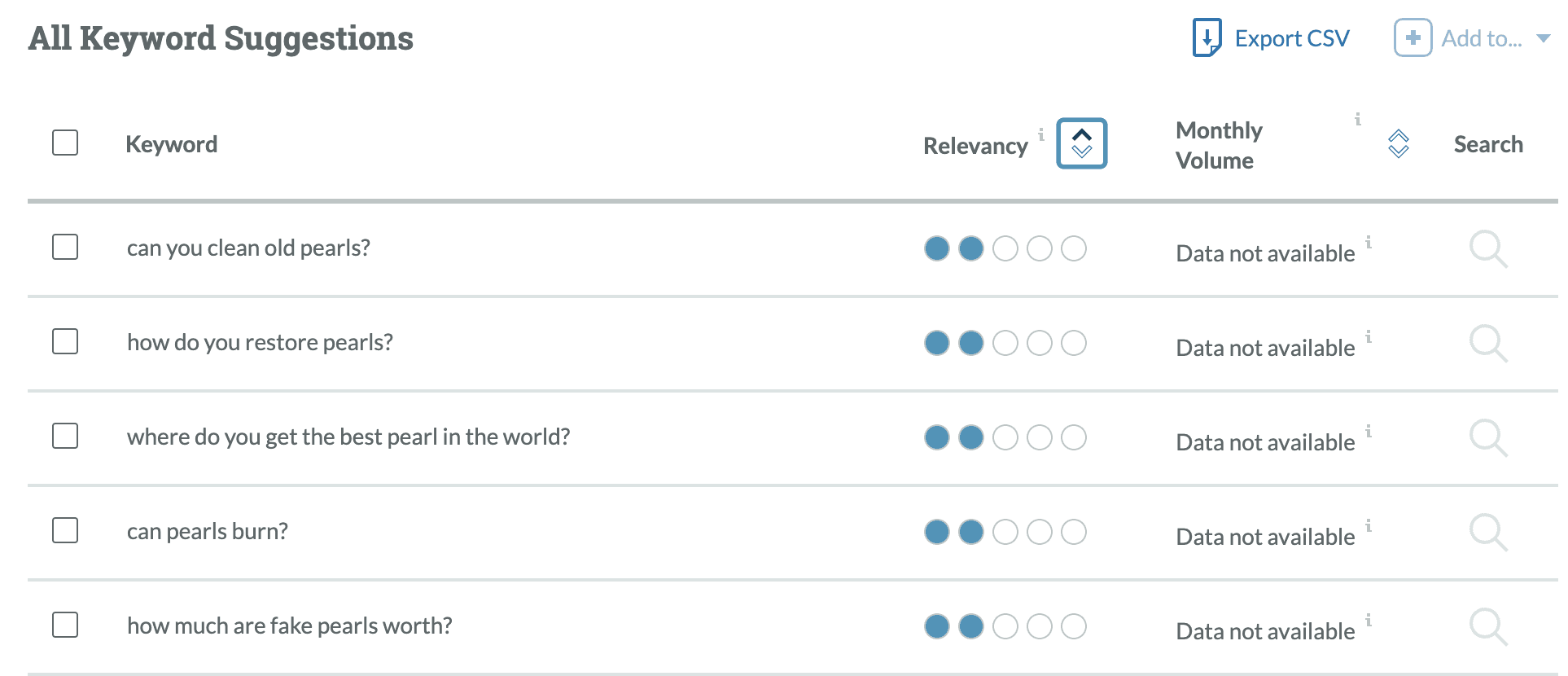
Now reverse the volume filter so that it’s showing lower-volume search terms and scroll down through the end of the tail to explore the lower-volume chatter.
If we don’t have tracked data in our database you can always cross reference with another data set to validate their value.
This is where your industry knowledge comes into play again. Bots, formulas, spreadsheets, and algorithms are all well and good, but don’t discount your own instincts and knowledge.
Use the suggestion filters to your advantage and play around with broader or more specific suggestion types.

Looking through the suggestions, I’ve noticed that the word “cultured” has popped up a few times.

To see these all bundled together, I want to look at the grouping options in Keyword Explorer. I like the high lexicon groups so I can see how much discussion is going on within my topics.
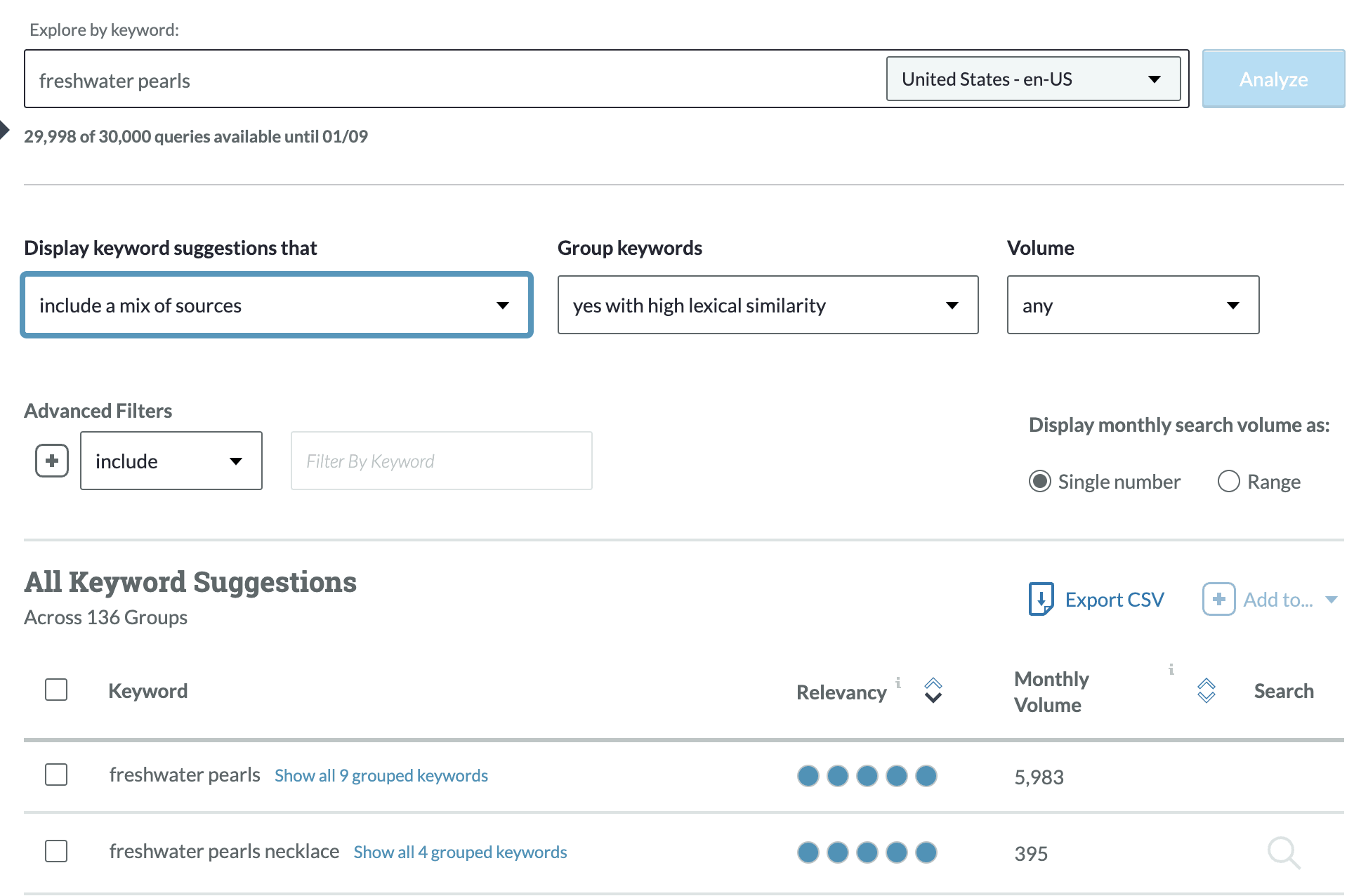
Scroll down and expand that group to get an idea of demand and assess intent.

I’m also interested in the words around “price” and “value,” so I’m doing the same and saving those to my sheet, along with the search volume. A few attempts at researching the “cleaning” of pearls wasn’t very fruitful, so I’ve adjusted my search to “clean freshwater pearls.”
Because I’m a keyword questions fanatic, I’m also going to filter by questions (the bottom option from the drop-down menu):
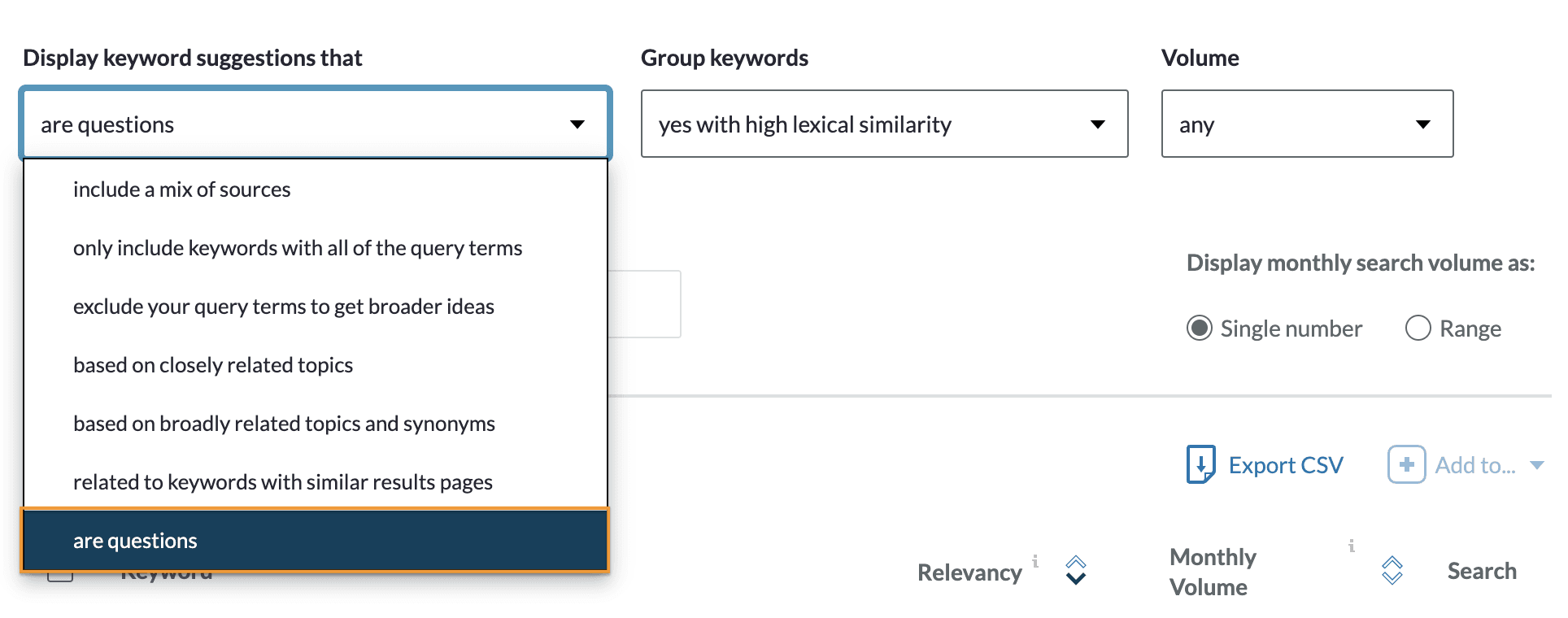
OK! How is our keyword list looking? Pretty darn hot, I reckon! We’ve gathered together a list of keywords and dug into the long tail of these sub-niches, and right alongside we’ve got search volume.

You’ll notice that some of the keywords I discovered in the bronze stage don’t have any data showing up in Keyword Explorer (indicated by the hyphen in the screenshot above). That’s ok — they’re still topics I can research further. This is exactly why we have assessed demand; no wild goose chase for us!
Ok, we’re drawing some conclusions, we’re building our list, and we’re making educated decisions. Congrats on your silver-level keyword wizardry! 😀
Gold medal: Find out who you’re competing with
We’re not operating in a vacuum. There’s always someone out there trying to elbow their way onto the first page. Don’t fall into the trap of thinking that just because it’s a long tail term with a nice chunk of search volume all those clicks will rain down on you. If the terms you’re looking to target already have big names headlining, this could very well alter your roadmap.
To reap the rewards of targeting the long tail, you’ll have to make sure you can outperform your competition.
Manually check the SERPs
Check out who’s showing up in the search engine results page (SERPs) by running a search for your head term. Make sure you’re signed out of Google and in an incognito tab.
We’re focusing on the organic results to find out if there are any weaker URLs you can pick off.
I’ll start with “freshwater pearls” for illustrative purposes.
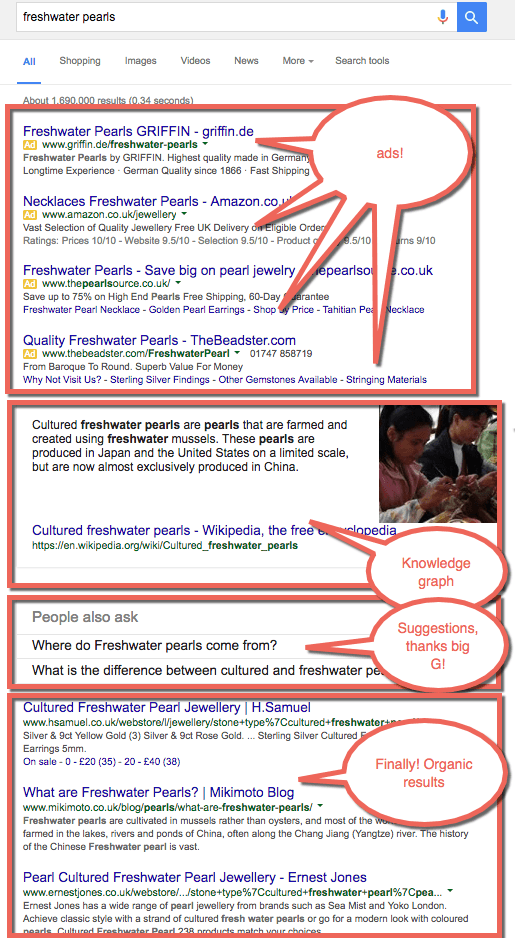
Whoooaaa, this is a noisy page. I’ve had to scroll a whole 2.5cm on my magic mouse (that’s very nearly a whole inch for the imperialists among us) just to see any organic results.
Let’s install the Mozbar to discover some metrics on the fly, like domain authority and back-linking data.
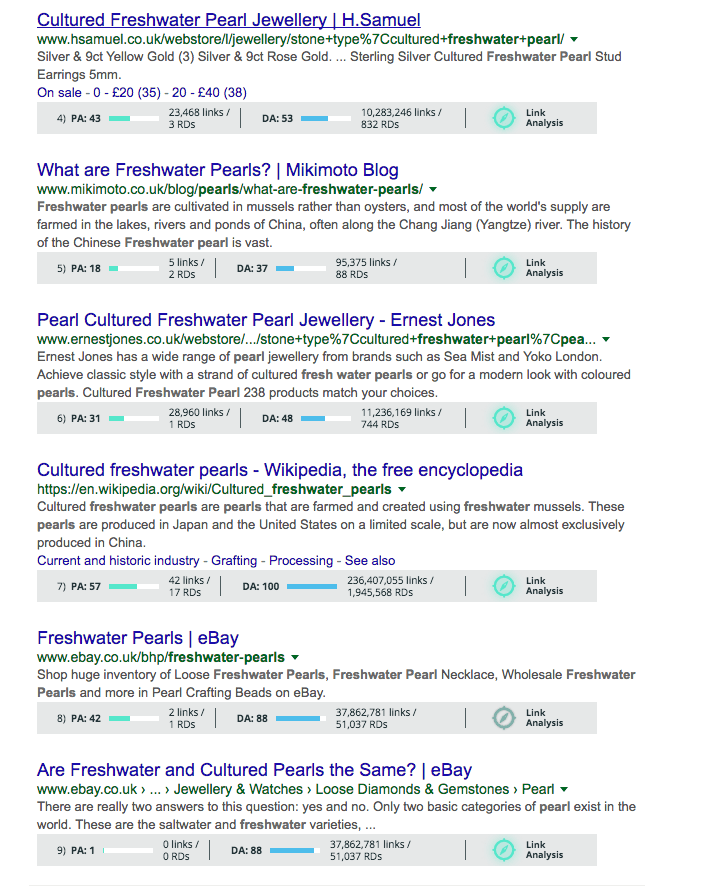
Now, if seeing those big players in the SERPs doesn’t make it clear, looking at the Mozbar metrics certainly does. This is exclusive real estate. It’s dominated by retailers, although Wikipedia gets a place in the middle of the page.
Let’s get into the mind of Google for a second. It — or should I say “they” (I can’t decide if it’s more creepy for Google to be referred to as a singular or plural pronoun. Let’s go with “they”) — anyway, I digress. “They” are guessing that we’re looking to buy pearls, but they’re also offering results on what they are.
This sort of information is offered up by big retailers who have created content that targets the intention of searchers. Mikimoto drives us to their blog post all about where freshwater pearls come from.

As you get deeper into the long tail of your niche, you’ll begin to come across sites you might not be so familiar with. So go and have a peek at their content.
With a little bit of snooping you can easily find out:
-
how relevant the article is
-
if it looks appealing, up to date, and sharable
-
be really judge-y: why not?
Now let’s find some more:
-
when the article was published
-
when their site was created
-
how often their blog is updated
-
how many other sites are linking to the page with Link Explorer
-
how many tweets, likes, etc.
Learn more about how to do a competitor analysis in our free guide, and don’t forget to download the handy worksheet.
Document all of your findings in our spreadsheet from earlier to keep track of the data. This information will now inform you of your chances of ranking for that term.
Manually checking out your competition is something that I would strongly recommend. But we don’t have all the time in the world to check each results page for each keyword we’re interested in.
Keyword Explorer leaps to our rescue again
Run your search and click on “SERP Analysis” to see what the first page looks like, along with authority metrics and social activity.

All the metrics for the organic results, like Page Authority, goes into calculating the Difficulty score above (lower is better).
And all those other factors — the ads and suggestions taking up space on the SERPs — that’s what’s used to calculate Organic CTR (higher is better).
Priority is all the other metrics tallied up. You definitely want this to be higher.
So now we have 3 important numerical values we can use to gauge our competition. We can use these values to compare keywords.
After a few searches in Keyword Explorer, you’re going to start hankering for a keyword list or two. For this you’ll need a paid subscription, or a Moz Pro 30-day free trial.
It’s well worth the sign-up; not only do you get 5,000 keyword queries per month and 30 lists (on the Medium plan), but you also get to check out the super-magical-KWE-mega-list-funky-cool metric page. That’s what I call it, just rolls off the tongue, you know?
Okay, fellow list buddies, let’s go and add those terms we’re interested in to our lovely new list.

Then head up to your lists on the top right and open up the one you just created.
Now we can see the spread of demand, competition and SERP features for our whole list.
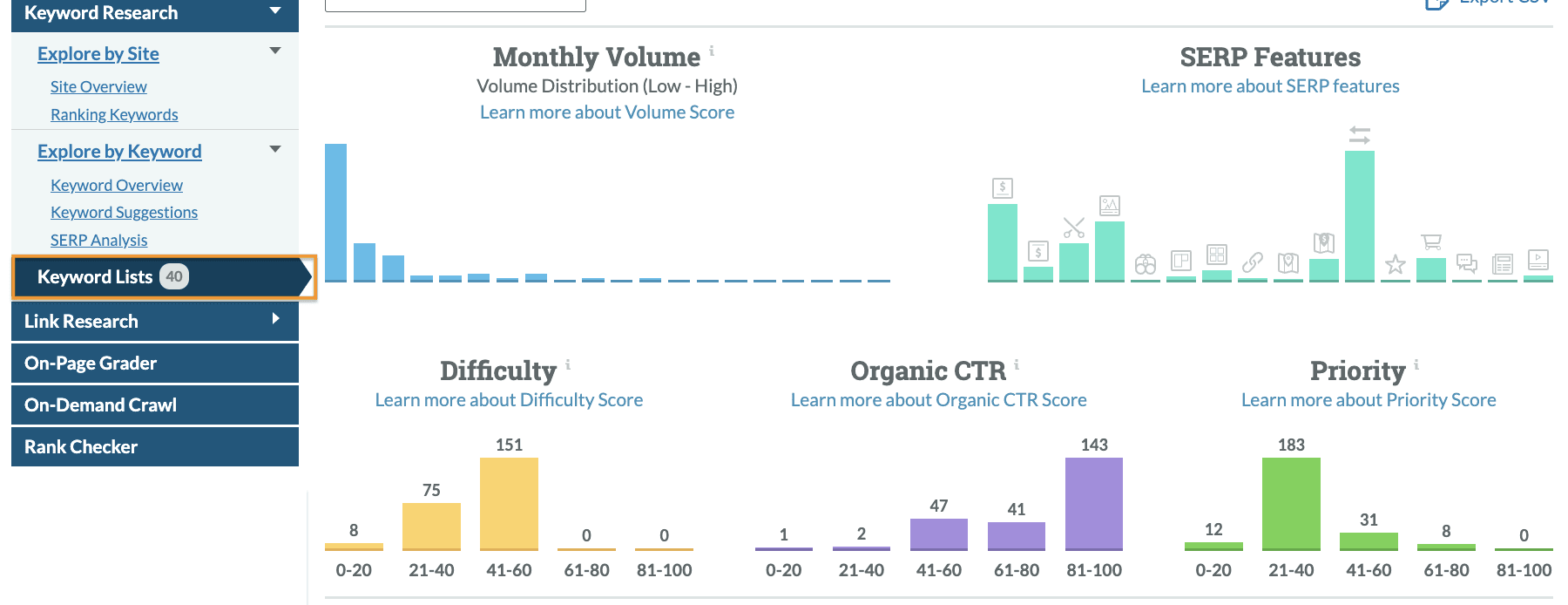
You can compare Volume, SERPS Features, Difficulty, Organic CTR, and Priority across multiple lists, topics, and niches.
How to compare apples with apples
Comparing keywords is something our support team gets questions about all the time.
Should I target this word or that word?
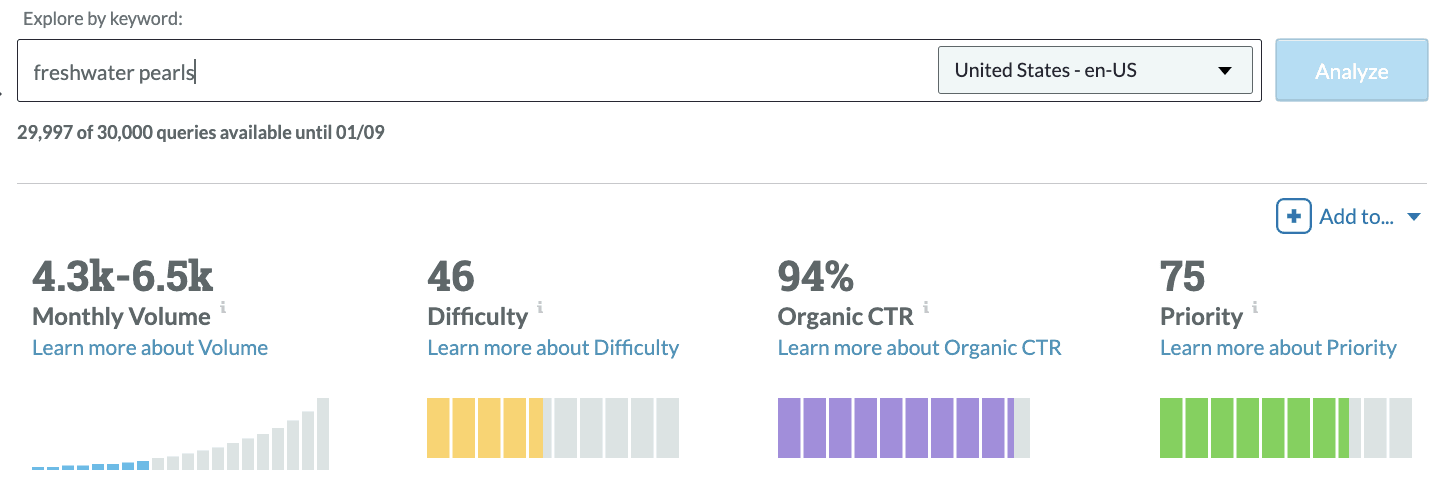
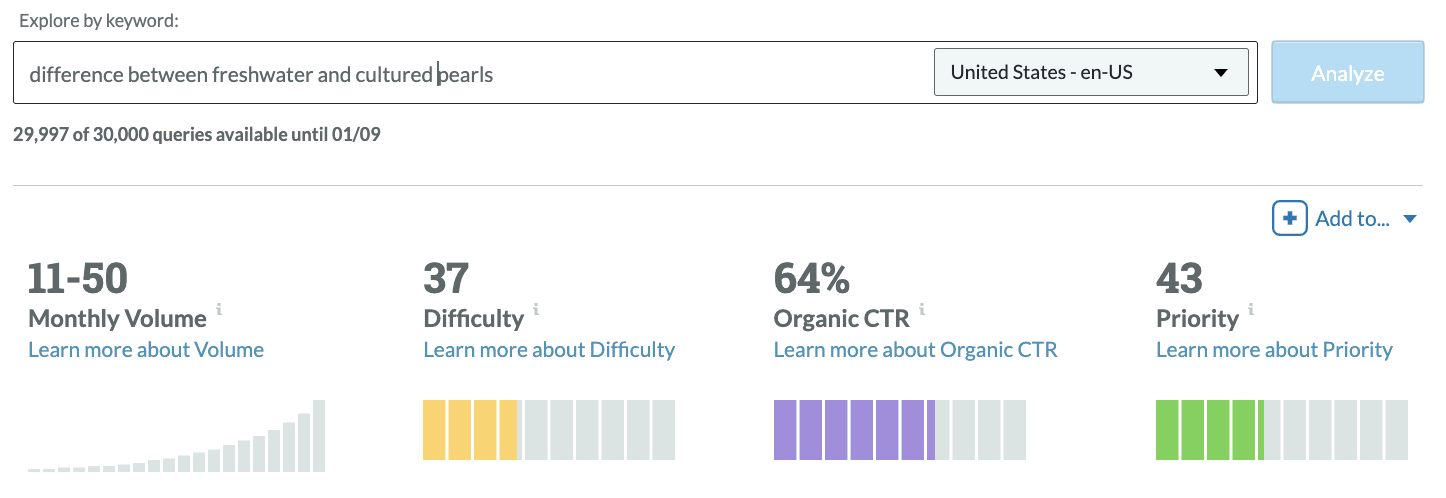
For the long tail keyword, the Volume is a lot lower, Difficulty is also down, the Organic CTR is a bit up, and overall the Priority is down because of the drop in search volume.
But don’t discount it! By targeting these sorts of terms, you’re focusing more on the intent of the searcher. You’re also making your content relevant for all the other neighboring search terms.
Let’s compare the difference between freshwater and cultured pearls with how much are freshwater pearls worth.
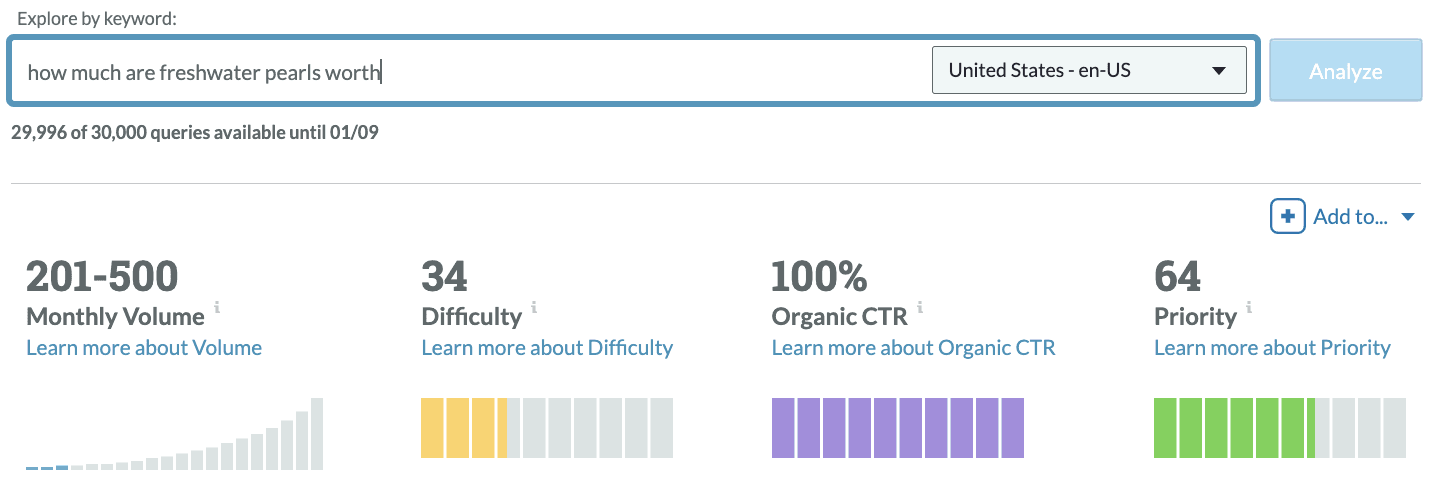
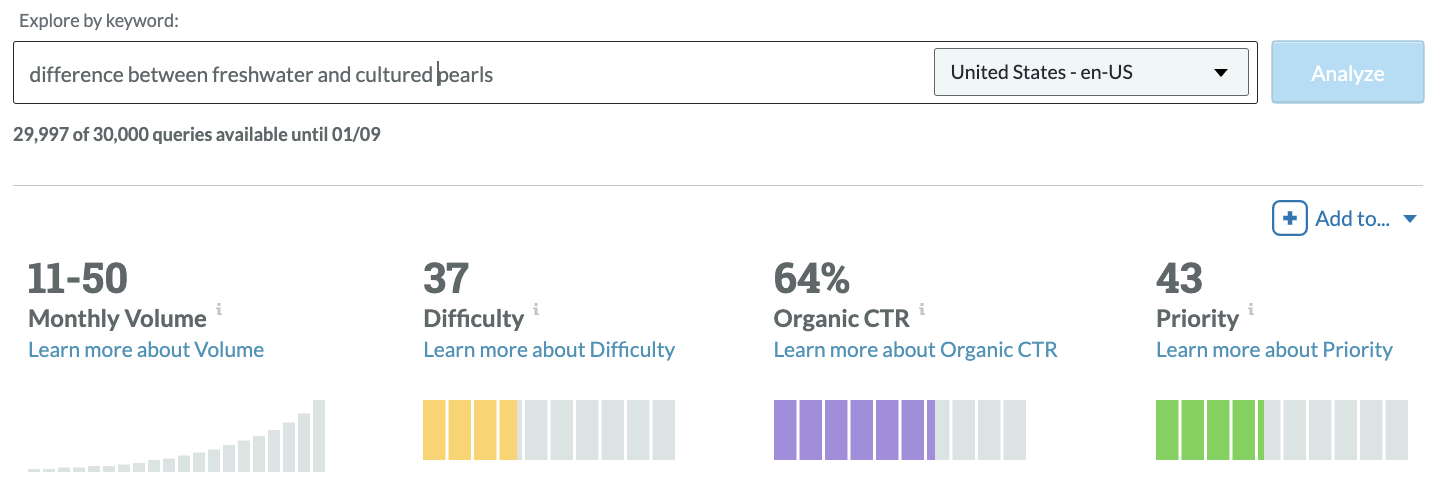
Search volume is the same, but for the keyword how much are freshwater pearls worth Difficulty is up, but so is the overall Priority because the Organic CTR is higher.
But just because you’re picking between two long tail keywords doesn’t mean you’ve fully understood the long tail of search.
You know all those keywords I grabbed for my list earlier in this post? Well, here they are sorted into topics.

Look at all the different ways people search for the same thing. This is what drives the long tail of search — searcher diversity. If you tally all the volume up for the cultured topic, we’ve got a bigger group of keywords and overall more search volume. This is where you can use Keyword Explorer and the long tail to make informed decisions.
You’re laying out your virtual welcome mat for all the potential traffic these terms send.
Platinum level: I lied — there’s one more level!
For all you lovely overachievers out there who have reached the end of this post, I’m going to reward you with one final tip.
You’ve done all the snooping around on your competitors, so you know who you’re up against. You’ve done the research, so you know what keywords to target to begin driving intent-rich traffic.
Now you need to create strong, consistent, and outstanding content.
As Dr Pete confirmed:
We don’t have to work ourselves to death to target the long tail of search. It doesn’t take 10,000 pieces of content to rank for 10,000 variants of a phrase, and Google (and our visitors) would much prefer we not spin out that content. The new, post-NLP (Natural Language Processing) long tail of SEO requires us to understand how our keywords fit into semantic space, mapping their relationships and covering the core concepts. Study your SERPs diligently, and you can find the patterns to turn your own long tail of keywords into a chonky thorax of opportunity.
Here’s where you really have to tip your hat to long tail keywords, because by strategically targeting the long tail you can start to build enough authority in the industry to beat stronger competition and rank higher for more competitive keywords in your niche.
Wrapping up…
The various different keyword phrases that make up the long tail in your industry are vast, often easier to rank for, and indicate stronger intent from the searcher. By targeting them you’ll find you can start to rank for relevant phrases sooner than if you just targeted the head. And over time, if you get the right signals, you’ll be able to rank for keywords with tougher competition. Pretty sweet, huh? Give Moz’s Keyword Explorer tool a whirl and let me know how you get on 🙂
MARKETING
5 Psychological Tactics to Write Better Emails

Welcome to Creator Columns, where we bring expert HubSpot Creator voices to the Blogs that inspire and help you grow better.
I’ve tested 100s of psychological tactics on my email subscribers. In this blog, I reveal the five tactics that actually work.
You’ll learn about the email tactic that got one marketer a job at the White House.
You’ll learn how I doubled my 5 star reviews with one email, and why one strange email from Barack Obama broke all records for donations.
5 Psychological Tactics to Write Better Emails
Imagine writing an email that’s so effective it lands you a job at the White House.
Well, that’s what happened to Maya Shankar, a PhD cognitive neuroscientist. In 2014, the Department of Veterans Affairs asked her to help increase signups in their veteran benefit scheme.
Maya had a plan. She was well aware of a cognitive bias that affects us all—the endowment effect. This bias suggests that people value items higher if they own them. So, she changed the subject line in the Veterans’ enrollment email.
Previously it read:
- Veterans, you’re eligible for the benefit program. Sign up today.
She tweaked one word, changing it to:
- Veterans, you’ve earned the benefits program. Sign up today.
This tiny tweak had a big impact. The amount of veterans enrolling in the program went up by 9%. And Maya landed a job working at the White House

Inspired by these psychological tweaks to emails, I started to run my own tests.
Alongside my podcast Nudge, I’ve run 100s of email tests on my 1,000s of newsletter subscribers.
Here are the five best tactics I’ve uncovered.
1. Show readers what they’re missing.
Nobel prize winning behavioral scientists Daniel Kahneman and Amos Tversky uncovered a principle called loss aversion.
Loss aversion means that losses feel more painful than equivalent gains. In real-world terms, losing $10 feels worse than how gaining $10 feels good. And I wondered if this simple nudge could help increase the number of my podcast listeners.
For my test, I tweaked the subject line of the email announcing an episode. The control read:
“Listen to this one”
In the loss aversion variant it read:
“Don’t miss this one”
It is very subtle loss aversion. Rather than asking someone to listen, I’m saying they shouldn’t miss out. And it worked. It increased the open rate by 13.3% and the click rate by 12.5%. Plus, it was a small change that cost me nothing at all.

2. People follow the crowd.
In general, humans like to follow the masses. When picking a dish, we’ll often opt for the most popular. When choosing a movie to watch, we tend to pick the box office hit. It’s a well-known psychological bias called social proof.
I’ve always wondered if it works for emails. So, I set up an A/B experiment with two subject lines. Both promoted my show, but one contained social proof.
The control read: New Nudge: Why Brands Should Flaunt Their Flaws
The social proof variant read: New Nudge: Why Brands Should Flaunt Their Flaws (100,000 Downloads)
I hoped that by highlighting the episode’s high number of downloads, I’d encourage more people to listen. Fortunately, it worked.
The open rate went from 22% to 28% for the social proof version, and the click rate, (the number of people actually listening to the episode), doubled.
3. Praise loyal subscribers.
The consistency principle suggests that people are likely to stick to behaviours they’ve previously taken. A retired taxi driver won’t swap his car for a bike. A hairdresser won’t change to a cheap shampoo. We like to stay consistent with our past behaviors.
I decided to test this in an email.
For my test, I attempted to encourage my subscribers to leave a review for my podcast. I sent emails to 400 subscribers who had been following the show for a year.
The control read: “Could you leave a review for Nudge?”
The consistency variant read: “You’ve been following Nudge for 12 months, could you leave a review?”
My hypothesis was simple. If I remind people that they’ve consistently supported the show they’ll be more likely to leave a review.
It worked.
The open rate on the consistency version of the email was 7% higher.
But more importantly, the click rate, (the number of people who actually left a review), was almost 2x higher for the consistency version. Merely telling people they’d been a fan for a while doubled my reviews.
4. Showcase scarcity.
We prefer scarce resources. Taylor Swift gigs sell out in seconds not just because she’s popular, but because her tickets are hard to come by.
Swifties aren’t the first to experience this. Back in 1975, three researchers proved how powerful scarcity is. For the study, the researchers occupied a cafe. On alternating weeks they’d make one small change in the cafe.
On some weeks they’d ensure the cookie jar was full.
On other weeks they’d ensure the cookie jar only contained two cookies (never more or less).
In other words, sometimes the cookies looked abundantly available. Sometimes they looked like they were almost out.
This changed behaviour. Customers who saw the two cookie jar bought 43% more cookies than those who saw the full jar.
It sounds too good to be true, so I tested it for myself.
I sent an email to 260 subscribers offering free access to my Science of Marketing course for one day only.
In the control, the subject line read: “Free access to the Science of Marketing course”
For the scarcity variant it read: “Only Today: Get free access to the Science of Marketing Course | Only one enrol per person.”
130 people received the first email, 130 received the second. And the result was almost as good as the cookie finding. The scarcity version had a 15.1% higher open rate.

5. Spark curiosity.
All of the email tips I’ve shared have only been tested on my relatively small audience. So, I thought I’d end with a tip that was tested on the masses.
Back in 2012, Barack Obama and his campaign team sent hundreds of emails to raise funds for his campaign.
Of the $690 million he raised, most came from direct email appeals. But there was one email, according to ABC news, that was far more effective than the rest. And it was an odd one.
The email that drew in the most cash, had a strange subject line. It simply said “Hey.”
The actual email asked the reader to donate, sharing all the expected reasons, but the subject line was different.
It sparked curiosity, it got people wondering, is Obama saying Hey just to me?
Readers were curious and couldn’t help but open the email. According to ABC it was “the most effective pitch of all.”
Because more people opened, it raised more money than any other email. The bias Obama used here is the curiosity gap. We’re more likely to act on something when our curiosity is piqued.

Loss aversion, social proof, consistency, scarcity and curiosity—all these nudges have helped me improve my emails. And I reckon they’ll work for you.
It’s not guaranteed of course. Many might fail. But running some simple a/b tests for your emails is cost free, so why not try it out?
This blog is part of Phill Agnew’s Marketing Cheat Sheet series where he reveals the scientifically proven tips to help you improve your marketing. To learn more, listen to his podcast Nudge, a proud member of the Hubspot Podcast Network.
MARKETING
The power of program management in martech

As a supporter of the program perspective for initiatives, I recognize the value of managing related projects, products and activities as a unified entity.
While one-off projects have their place, they often involve numerous moving parts and in my experience, using a project-based approach can lead to crucial elements being overlooked. This is particularly true when building a martech stack or developing content, for example, where a program-based approach can ensure that all aspects are considered and properly integrated.
For many CMOs and marketing organizations, programs are becoming powerful tools for aligning diverse initiatives and driving strategic objectives. Let’s explore the essential role of programs in product management, project management and marketing operations, bridging technical details with business priorities.
Programs in product management
Product management is a fascinating domain where programs operate as a strategic framework, coordinating related products or product lines to meet specific business objectives.
Product managers are responsible for defining a product or product line’s strategy, roadmap and features. They work closely with program managers, who ensure alignment with market demands, customer needs and the company’s overall vision by managing offerings at a program level.
Program managers optimize the product portfolio, make strategic decisions about resource allocation and ensure that each product contributes to the program’s goals. One key aspect of program management in product management is identifying synergies between products.
Program managers can drive innovation and efficiency across the portfolio by leveraging shared technologies, customer insights, or market trends. This approach enables organizations to respond quickly to changing market conditions, seize emerging opportunities and maintain a competitive advantage. Product managers, in turn, use these insights to shape the direction of individual products.
Moreover, programs in product management facilitate cross-functional collaboration and knowledge sharing. Program managers foster a holistic understanding of customer needs and market dynamics by bringing together teams from various departments, such as engineering, marketing and sales.
Product managers also play a crucial role in this collaborative approach, ensuring that all stakeholders work towards common goals, ultimately leading to more successful product launches and enhanced customer satisfaction.
Dig deeper: Understanding different product roles in marketing technology acquisition
Programs in project management
In project management, programs provide a structured approach for managing related projects as a unified entity, supporting broader strategic objectives. Project managers are responsible for planning, executing and closing individual projects within a program. They focus on specific deliverables, timelines and budgets.
On the other hand, program managers oversee these projects’ coordination, dependencies and outcomes, ensuring they collectively deliver the desired benefits and align with the organization’s strategic goals.
A typical example of a program in project management is a martech stack optimization initiative. Such a program may involve integrating marketing technology tools and platforms, implementing customer data management systems and training employees on the updated technologies. Project managers would be responsible for the day-to-day management of each project.
In contrast, the program manager ensures a cohesive approach, minimizes disruptions and realizes the full potential of the martech investments to improve marketing efficiency, personalization and ROI.
The benefits of program management in project management are numerous. Program managers help organizations prioritize initiatives that deliver the greatest value by aligning projects with strategic objectives. They also identify and mitigate risks that span multiple projects, ensuring that issues in one area don’t derail the entire program. Project managers, in turn, benefit from this oversight and guidance, as they can focus on successfully executing their projects.
Additionally, program management enables efficient resource allocation, as skills and expertise can be shared across projects, reducing duplication of effort and maximizing value. Project managers can leverage these resources and collaborate with other project teams to achieve their objectives more effectively.
Dig deeper: Combining martech projects: 5 questions to ask
Programs in marketing operations
In marketing operations, programs play a vital role in integrating and managing various marketing activities to achieve overarching goals. Marketing programs encompass multiple initiatives, such as advertising, content marketing, social media and event planning. Organizations ensure consistent messaging, strategic alignment, and measurable results by managing these activities as a cohesive program.
In marketing operations, various roles, such as MOps managers, campaign managers, content managers, digital marketing managers and analytics managers, collaborate to develop and execute comprehensive marketing plans that support the organization’s business objectives.
These professionals work closely with cross-functional teams, including creative, analytics and sales, to ensure that all marketing efforts are coordinated and optimized for maximum impact. This involves setting clear goals, defining key performance indicators (KPIs) and continuously monitoring and adjusting strategies based on data-driven insights.
One of the primary benefits of a programmatic approach in marketing operations is maintaining a consistent brand voice and message across all channels. By establishing guidelines and standards for content creation, visual design and customer interactions, marketing teams ensure that the brand’s identity remains cohesive and recognizable. This consistency builds customer trust, reinforces brand loyalty and drives business growth.
Programs in marketing operations enable organizations to take a holistic approach to customer engagement. By analyzing customer data and feedback across various touchpoints, marketing professionals can identify opportunities for improvement and develop targeted strategies to enhance the customer experience. This customer-centric approach leads to increased satisfaction, higher retention rates and more effective marketing investments.
Dig deeper: Mastering the art of goal setting in marketing operations
Embracing the power of programs for long-term success
We’ve explored how programs enable marketing organizations to drive strategic success and create lasting impact by aligning diverse initiatives across product management, project management and marketing operations.
- Product management programs facilitate cross-functional collaboration and ensure alignment with market demands.
- In project management, they provide a structured approach for managing related projects and mitigating risks.
- In marketing operations, programs enable consistent messaging and a customer-centric approach to engagement.
Program managers play a vital role in maintaining strategic alignment, continuously assessing progress and adapting to changes in the business environment. Keeping programs aligned with long-term objectives maximizes ROI and drives sustainable growth.
Organizations that invest in developing strong program management capabilities will be better positioned to optimize resources, foster innovation and achieve their long-term goals.
As a CMO or marketing leader, it is important to recognize the strategic value of programs and champion their adoption across your organization. By aligning efforts across various domains, you can unlock the full potential of your initiatives and drive meaningful results. Try it, you’ll like it.
Fuel for your marketing strategy.
Opinions expressed in this article are those of the guest author and not necessarily MarTech. Staff authors are listed here.
MARKETING
2 Ways to Take Back the Power in Your Business: Part 2


Before we dive into the second way to assume power in your business, let’s revisit Part 1.
Who informs your marketing strategy?
YOU, with your carefully curated strategy informed by data and deep knowledge of your brand and audience? Or any of the 3 Cs below?
- Competitors: Their advertising and digital presence and seemingly never-ending budgets consume the landscape.
- Colleagues: Their tried-and-true proven tactics or lessons learned.
- Customers: Their calls, requests, and ideas.
Considering any of the above is not bad, in fact, it can be very wise! However, listening quickly becomes devastating if it lends to their running our business or marketing department.
It’s time we move from defense to offense, sitting in the driver’s seat rather than allowing any of the 3 Cs to control.
It is one thing to learn from and entirely another to be controlled by.
In Part 1, we explored how knowing what we want is critical to regaining power.
1) Knowing what you want protects the bottom line.
2) Knowing what you want protects you from the 3 Cs.
3) Knowing what you want protects you from running on auto-pilot.
You can read Part 1 here; in the meantime, let’s dive in!
How to Regain Control of Your Business: Knowing Who You Are
Vertical alignment is a favorite concept of mine, coined over the last two years throughout my personal journey of knowing self.
Consider the diagram below.


Vertical alignment is the state of internal being centered with who you are at your core.
Horizontal alignment is the state of external doing engaged with the world around you.
In a state of vertical alignment, your business operates from its core center, predicated on its mission, values, and brand. It is authentic and confident and cuts through the noise because it is entirely unique from every competitor in the market.
From this vertical alignment, your business is positioned for horizontal alignment to fulfill the integrity of its intended services, instituted processes, and promised results.
A strong brand is not only differentiated in the market by its vertical alignment but delivers consistently and reliably in terms of its products, offerings, and services and also in terms of the customer experience by its horizontal alignment.
Let’s examine what knowing who you are looks like in application, as well as some habits to implement with your team to strengthen vertical alignment.
1) Knowing who You are Protects You from Horizontal Voices.
The strength of “Who We Are” predicates the ability to maintain vertical alignment when something threatens your stability. When a colleague proposes a tactic that is not aligned with your values. When the customer comes calling with ideas that will knock you off course as bandwidth is limited or the budget is tight.
I was on a call with a gal from my Mastermind when I mentioned a retreat I am excited to launch in the coming months.
I shared that I was considering its positioning, given its curriculum is rooted in emotional intelligence (EQ) to inform personal brand development. The retreat serves C-Suite, but as EQ is not a common conversation among this audience, I was considering the best positioning.


She advised, “Sell them solely on the business aspects, and then sneak attack with the EQ when they’re at the retreat!”
At first blush, it sounds reasonable. After all, there’s a reason why the phrase, “Sell the people what they want, give them what they need,” is popular.
Horizontal advice and counsel can produce a wealth of knowledge. However, we must always approach the horizontal landscape – the external – powered by vertical alignment – centered internally with the core of who we are.
Upon considering my values of who I am and the vision of what I want for this event, I realized the lack of transparency is not in alignment with my values nor setting the right expectations for the experience.
Sure, maybe I would get more sales; however, my bottom line — what I want — is not just sales. I want transformation on an emotional level. I want C-Suite execs to leave powered from a place of emotional intelligence to decrease decisions made out of alignment with who they are or executing tactics rooted in guilt, not vision.
Ultimately, one of my core values is authenticity, and I must make business decisions accordingly.
2) Knowing who You are Protects You from Reactivity.
Operating from vertical alignment maintains focus on the bottom line and the strategy to achieve it. From this position, you are protected from reacting to the horizontal pressures of the 3 Cs: Competitors, Colleagues, and Customers.
This does not mean you do not adjust tactics or learn.


However, your approach to adjustments is proactive direction, not reactive deviations. To do this, consider the following questions:
First: How does their (any one of the 3 Cs) tactic measure against my proven track record of success?
If your colleague promotes adding newsletters to your strategy, lean in and ask, “Why?”
- What are their outcomes?
- What metrics are they tracking for success?
- What is their bottom line against yours?
- How do newsletters fit into their strategy and stage(s) of the customer journey?
Always consider your historical track record of success first and foremost.
Have you tried newsletters in the past? Is their audience different from yours? Why are newsletters good for them when they did not prove profitable for you?
Operate with your head up and your eyes open.
Maintain focus on your bottom line and ask questions. Revisit your data, and don’t just take their word for it.
2. Am I allocating time in my schedule?
I had coffee with the former CEO of Jiffy Lube, who built the empire that it is today.
He could not emphasize more how critical it is to allocate time for thinking. Just being — not doing — and thinking about your business or department.


Especially for senior leaders or business owners, but even still for junior staff.
The time and space to be fosters creative thinking, new ideas, and energy. Some of my best campaigns are conjured on a walk or in the shower.
Kasim Aslam, founder of the world’s #1 Google Ads agency and a dear friend of mine, is a machine when it comes to hacks and habits. He encouraged me to take an audit of my calendar over the last 30 days to assess how I spend time.
“Create three buckets,” he said. “Organize them by the following:
- Tasks that Generate Revenue
- Tasks that Cost Me Money
- Tasks that Didn’t Earn Anything”
He and I chatted after I completed this exercise, and I added one to the list: Tasks that are Life-Giving.
Friends — if we are running empty, exhausted, or emotionally depleted, our creative and strategic wherewithal will be significantly diminished. We are holistic creatures and, therefore, must nurture our mind, body, soul, and spirit to maintain optimum capacity for impact.


I shared this hack with a friend of mine. Not only did she identify meetings that were costing her money and thus needed to be eliminated, but she also identified that particular meetings could actually turn revenue-generating! She spent a good amount of time each month facilitating introductions; now, she is adding Strategic Partnerships to her suite of services.
ACTION: Analyze your calendar’s last 30-60 days against the list above.
Include what is life-giving!
How are you spending your time? What is the data showing you? Are you on the path to achieving what you want and living in alignment with who you want to be?
Share with your team or business partner for the purpose of accountability, and implement practical changes accordingly.
Finally, remember: If you will not protect your time, no one else will.
3) Knowing who You are Protects You from Lack.
“What are you proud of?” someone asked me last year.
“Nothing!” I reply too quickly. “I know I’m not living up to my potential or operating in the full capacity I could be.”


They looked at me in shock. “You need to read The Gap And The Gain.”
I silently rolled my eyes.
I already knew the premise of the book, or I thought I did. I mused: My vision is so big, and I have so much to accomplish. The thought of solely focusing on “my wins” sounded like an excuse to abdicate personal responsibility.
But I acquiesced.
The premise of this book is to measure one’s self from where they started and the success from that place to where they are today — the gains — rather than from where they hope to get and the seemingly never-ending distance — the gap.
Ultimately, Dr. Benjamin Hardy and Dan Sullivan encourage changing perspectives to assign success, considering the starting point rather than the destination.
The book opens with the following story:
Dan Jensen was an Olympic speed skater, notably the fastest in the world. But in each game spanning a decade, Jansen could not catch a break. “Flukes” — even tragedy with the death of his sister in the early morning of the 1988 Olympics — continued to disrupt the prediction of him being favored as the winner.


The 1994 Olympics were the last of his career. He had one more shot.
Preceding his last Olympics in 1994, Jansen adjusted his mindset. He focused on every single person who invested in him, leading to this moment. He considered just how very lucky he was to even participate in the first place. He thought about his love for the sport itself, all of which led to an overwhelming realization of just how much he had gained throughout his life.
He raced the 1994 Olympic games differently, as his mindset powering every stride was one of confidence and gratitude — predicated on the gains rather than the gap in his life.
This race secured him his first and only gold medal and broke a world record, simultaneously proving one of the most emotional wins in Olympic history.
Friends, knowing who we are on the personal and professional level, can protect us from those voices of shame or guilt that creep in.
PERSONAL ACTION: Create two columns. On one side, create a list of where you were when you started your business or your position at your company. Include skills and networks and even feelings about where you were in life. On the other side, outline where you are today.
Look at how far you’ve come.
COMPANY ACTION: Implement a quarterly meeting to review the past three months. Where did you start? Where are you now?
Celebrate the gain!
Only from this place of gain mindset, can you create goals for the next quarter predicated on where you are today.
Ultimately, my hope for you is that you deliver exceptional and memorable experiences laced with empathy toward the customer (horizontally aligned) yet powered by the authenticity of the brand (vertically aligned).
Aligning vertically maintains our focus on the bottom line and powers horizontal fulfillment.


Want to get certified in Content Marketing?
Leverage the tools and channels to predictably and profitably drive awareness, leads, sales, and referrals—EVERYTHING you need to know to become a true master of digital marketing. Click Here
Granted, there will be strategic times and seasons for adjustment; however, these changes are to be made on the heels of consulting who we are as a brand — not in reaction to the horizontal landscape of what is the latest and greatest in the industry.
In Conclusion…
Taking back control of your business and marketing strategies requires a conscious effort to resist external pressures and realign with what you want and who you are.
Final thoughts as we wrap up:
First, identify the root issue(s).
Consider which of the 3 Cs holds the most power: be it competition, colleagues, or customers.
Second, align vertically.
Vertical alignment facilitates individuality in the market and ensures you — and I — stand out and shine while serving our customers well.
Third, keep the bottom line in view.
Implement a routine that keeps you and your team focused on what matters most, and then create the cascading strategy necessary to accomplish it.
Fourth, maintain your mindsets.
Who You Are includes values for the internal culture. Guide your team in acknowledging the progress made along the way and embracing the gains to operate from a position of strength and confidence.
Fifth, maintain humility.
I cannot emphasize enough the importance of humility and being open to what others are doing. However, horizontal alignment must come after vertical alignment. Otherwise, we will be at the mercy of the whims and fads of everyone around us. Humility allows us to be open to external inputs and vertically aligned at the same time.
Buckle up, friends! It’s time to take back the wheel and drive our businesses forward.
The power lies with you and me.
-

 SEARCHENGINES6 days ago
SEARCHENGINES6 days agoMore Google March 2024 Core Update Ranking Volatility
-

 PPC6 days ago
PPC6 days agoCompetitor Monitoring: 7 ways to keep watch on the competition
-

 PPC5 days ago
PPC5 days agoA History of Google AdWords and Google Ads: Revolutionizing Digital Advertising & Marketing Since 2000
-

 WORDPRESS6 days ago
WORDPRESS6 days agoThrive Architect vs Divi vs Elementor
-

 PPC6 days ago
PPC6 days ago31 Ready-to-Go Mother’s Day Messages for Social Media, Email, & More
-

 WORDPRESS5 days ago
WORDPRESS5 days agoTurkish startup ikas attracts $20M for its e-commerce platform designed for small businesses
-

 MARKETING4 days ago
MARKETING4 days agoRoundel Media Studio: What to Expect From Target’s New Self-Service Platform
-

 MARKETING6 days ago
MARKETING6 days agoHow To Adapt Your SEO and Content Strategies for SGE and AI Experiences













![5 Psychological Tactics to Write Better Emails → Download Now: The Beginner's Guide to Email Marketing [Free Ebook]](https://articles.entireweb.com/wp-content/uploads/2023/02/11-Free-Email-Hacks-to-Step-Up-Your-Productivity.png)



